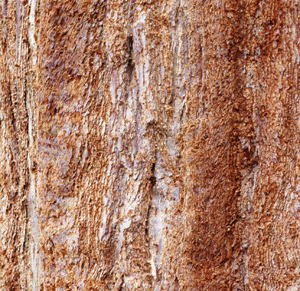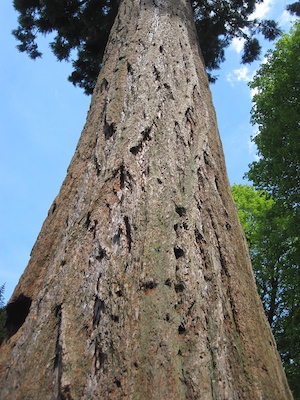Barking up the wrong tree?

In their natural environment, giant sequoias are to be found only in a high and narrow area on the western slopes of the Sierra Nevada. Like, bristlecones, giant sequoias (Sequoiadendron giganteum) are a long lived species - their life span can be 3000 years. However, their most spectacular feature is their sheer size - they can reach heights of 300 feet with a trunk that may be 20 feet or more in diameter. Indeed, the world’s largest tree (by volume) is General Sherman - a sequoia estimated to have a volume in excess of 52000 cubic feet.
The trees are not only long lived but ‘tough’. They have protection against fire and rock fall, both of which are hazards in their home habitat. Protection is afforded by their bark, which is very fibrous and can be up to 3 feet thick.
Recently, the nature of this bark has been investigated by researchers at the University of Freiberg. The fibres within the bark form a three dimensional network. These fibres (usually arranged in pairs) are organised into bundles, between which are air-filled cavities. The bundles overlap one another and form layers. If a rock hits the tree, then the air-filled cavities are compressed and the energy spread over a wide area; this helps protect the delicate cambium tissue from damage.  Though it may distort, the bark can return to its original shape after most rock impacts. The thickness of the bark and its insulating properties also protects the dividing cells of the cambium from damage by the wild fires that occur in this area. It is the cells of the cambium that create the bark and wood of the tree. The nature of the sequoia bark can be likened to the open-pored foam used in the insulation of houses.
Though it may distort, the bark can return to its original shape after most rock impacts. The thickness of the bark and its insulating properties also protects the dividing cells of the cambium from damage by the wild fires that occur in this area. It is the cells of the cambium that create the bark and wood of the tree. The nature of the sequoia bark can be likened to the open-pored foam used in the insulation of houses.
Also found on the western coast of the States are the coastal redwoods (Sequoia sempervirens), they too are at risk of intense fires (due in part to climate change and prolonged droughts). The redwoods are important trees as they can store massive amounts of carbon. To help offset any losses of these trees due to changing conditions, researchers have used information from high resolution maps and data on moisture availability (rain and fogs) to identify areas where coastal redwoods are found, and where they might be planted. They found that redwood habitats were mainly associated with streams and moisture availability. Identifying microrefugia, that is small areas where the coastal redwoods might be planted and survive is important as surrounding areas become climatically unsuitable.
Comments are closed for this post.
